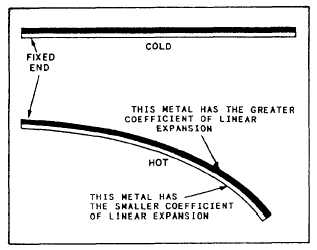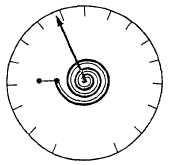Figure 11-11.—Effect of unequal expansion of a bimetallic strip.
has a bulb and a very fine-bore capillary tube. The tube
contains alcohol or some other liquid that uniformly
expands or contracts as the temperature rises or falls.
The selection of liquid is based on the temperature range
for which the thermometer is to be used.
Almost all liquid-in-glass thermometers are sealed
so atmospheric pressure does not affect the reading. The
space above the liquid in this type of thermometer may
be a vacuum, or this space maybe filled with an inert
gas, such as nitrogen, argon, or carbon dioxide.
The capillary bore may be round or elliptical. In
either case, it is very small; therefore, a relatively small
expansion or contraction of the liquid causes a relatively
large change in the position of the liquid in the capillary
tube. Although the capillary bore has a very small
diameter, the walls of the capillary tube are quite thick.
Most liquid-in-glass thermometers have an expansion
chamber at the top of the bore to provide a margin of
safety for the instrument if it should accidentally
overheat.
Liquid-in-glass thermometers may have
graduations etched directly on the glass stem or placed
on a separate strip of material located behind the stem.
Many thermometers used in shipboard engineering
plants have the graduations marked on a separate strip
because this type is generally easier to read.
You will find liquid-in-glass thermometers in use in
the oil and water test lab for analytical tests on fuel, oil,
and water.
Bimetallic Expansion Thermometers
Bimetallic expansion thermometers make use of
different metals having different coefficients of linear
expansion. The essential element in a bimetallic
expansion thermometer is a bimetallic strip consisting
of two layers of different metals fused together. When
such a strip is subjected to temperature changes, one
layer expands or contracts more than the other, thus
tending to change the curvature of the strip.
Figure 11-11 shows the basic principle of a
bimetallic expansion thermometer. One end of a straight
bimetallic strip is fixed in place. As the strip is heated,
the other end tends to curve away from the side that has
the greater coefficient of linear expansion.
When used in thermometers, the bimetallic strip is
normally wound into a flat spiral (fig. 11-12), a single
helix, or a multiple helix. The end of the strip that is not
fixed in position is fastened to the end of a pointer that
moves over a circular scale. Bimetallic thermometers
are easily adapted for use as recording thermometers; a
pen is attached to the pointer and positioned so that it
marks on a revolving chart.
Filled-System Thermometers
Generally, filled-system thermometers are used in
locations where the indicating part of the instrument
must be placed some distance away from the point
where the temperature is to be measured. For this reason,
they are often called distant-reading thermometers.
However, this is not true for filled-system
thermometers. In some designs, the capillary tubing is
very short or nonexistent. Generally, however,
filled-system thermometers are distant-reading
thermometers. Some distant-reading thermometers
have capillaries as long as 125 feet.
Figure 11-12.—Bimetallic thermometer (flat, spiral strip).
11-6




